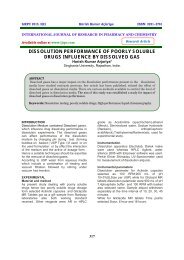a review on potential of plants under trapa species - ijrpc
a review on potential of plants under trapa species - ijrpc
a review on potential of plants under trapa species - ijrpc
Create successful ePaper yourself
Turn your PDF publications into a flip-book with our unique Google optimized e-Paper software.
IJRPC 2013, 3(2) Majee Chandana et al. ISSN: 22312781<br />
INTERNATIONAL JOURNAL OF RESEARCH IN PHARMACY AND CHEMISTRY<br />
Available <strong>on</strong>line at www.<strong>ijrpc</strong>.com<br />
Review Article<br />
A REVIEW ON POTENTIAL OF PLANTS UNDER TRAPA SPECIES<br />
Majee Chandana*, Mazumder Rupa and Chakraborthy GS.<br />
Department <strong>of</strong> Pharmaceutical technology , Noida Institute <strong>of</strong> Engineering & Technology19,<br />
Knowledege Park-II, Greater Noida, Uttar Pradesh- 201 306, India.<br />
ABSTRACT<br />
Medicinal <strong>plants</strong> are widely used by the Traditi<strong>on</strong>al Medical Practiti<strong>on</strong>ers for counteracting various<br />
diseases in their day to day practice. Plants <strong>of</strong> Trapa <strong>species</strong> (family: Trapaceae or Lythraceae),<br />
comm<strong>on</strong>ly known as ‘Water chestnut’ or ‘Water caltrop’ in English, are floating annual aquatic<br />
<strong>plants</strong>, growing in slow-moving water up to 5 meters deep. They are native to warm temperate<br />
parts <strong>of</strong> Eurasia and Africa. According to the Internati<strong>on</strong>al System <strong>of</strong> Medicines, different parts<br />
(leaves, stem and seeds) <strong>of</strong> the <strong>plants</strong> and even whole <strong>plants</strong> are used traditi<strong>on</strong>ally for several<br />
medicinal purposes. The juice <strong>of</strong> the fruits has been used for the treatment <strong>of</strong> diarrhea and<br />
dysentery; the <strong>plants</strong> are also used to combat fever, leprosy, fatigue, inflammati<strong>on</strong>, urethrorrhea,<br />
fractures, erysipelas, lumbago, pharyngitis, br<strong>on</strong>chitis and general debility. Thus this <str<strong>on</strong>g>review</str<strong>on</strong>g> will be<br />
lead to break through for explorati<strong>on</strong> <strong>of</strong> this <strong>species</strong> for its therapeutic <strong>potential</strong>.<br />
Keywords: Trapa <strong>species</strong>, traditi<strong>on</strong>al use, pharmacognostical investigati<strong>on</strong> pharmacological use.<br />
INTRODUCTION<br />
Water caltrop(Singara) is <strong>on</strong>e <strong>of</strong> the most<br />
popular vegetables used in Asia, due to its<br />
special feature and medicinal values which ; it<br />
is found in Taiwan, China and parts <strong>of</strong> South<br />
East Asia 1 . The Singhara nut is a valuable<br />
agricultural product, commercially cultivated in<br />
many parts <strong>of</strong> India, particularly in the Eastern<br />
and Southern regi<strong>on</strong>s 2 . Singhara is extensively<br />
grown in Uttar Pradesh, Madhya Pradesh, Bihar<br />
and Orissa, where high rainfall is c<strong>on</strong>ducive to<br />
successful cultivati<strong>on</strong> 3 . It c<strong>on</strong>tains carbohydrates,<br />
minerals, calcium, phosphate, ir<strong>on</strong>, copper,<br />
manganese, magnesium, sodium and potassium.<br />
The kernels c<strong>on</strong>tain some vitamins like thiamine,<br />
rib<strong>of</strong>lavin, nicotinic acid, vitamin C, vitamin A, D-<br />
amylase and c<strong>on</strong>siderable amount <strong>of</strong><br />
phosphorylases 4 . It is used in many Ayurvedic<br />
preparati<strong>on</strong>s as nutrient, appetizer, astringent,<br />
diuretic, aphrodisiac, t<strong>on</strong>ic, cooling and<br />
antidiarrheal agents. It is also useful in lumbago,<br />
sore throat, bilious affecti<strong>on</strong>s, br<strong>on</strong>chitis, fatigue<br />
and inflammati<strong>on</strong>. The medicinal values <strong>of</strong> the<br />
whole herb and fruit have l<strong>on</strong>g been recognized<br />
in folklore medicine as a cure for various<br />
diseases 5 . The whole herb has been reported for<br />
hepatoprotective activity 6 , antimicrobial activity,<br />
antibacterial activity 7 antitumor activity 8 ,<br />
antioxidant activity 9 and free radical scavenging<br />
activity 10 . Further, the fruits have been used as<br />
intestinal astringent, aphrodisiac, antiinflammatory,<br />
antileprotic agent and in urinary<br />
discharges, fractures, sore throat, br<strong>on</strong>chitis and<br />
anemia 11, 12 . In additi<strong>on</strong> to this, the juice <strong>of</strong> the<br />
fruit has been used for diarrhea and dysentery 13 .<br />
Fruits are also being used in making liniments<br />
for the cure <strong>of</strong> rheumatism, sores and sunburn.<br />
It is also said to have cancer-preventing<br />
properties. Stem juice is used in ophthalmic<br />
preparati<strong>on</strong>s 14, 15 . Due to high activity <strong>of</strong><br />
enzymes and phenolic c<strong>on</strong>tents, the color <strong>of</strong><br />
water caltrop hulls easily changes from original<br />
pink to dark brown during transportati<strong>on</strong> and<br />
processing 16 .<br />
History<br />
Water chestnut had been introduced from<br />
Europe as an ornamental plant. Dispersal is<br />
limited because <strong>of</strong> the large, sinking nuts, but<br />
Water chestnut has persisted and spread in the<br />
502
IJRPC 2013, 3(2) Majee Chandana et al. ISSN: 22312781<br />
Northeastern states. In the Chinese Zhou<br />
Dynasty, water caltrop was an important food<br />
for worship as prayer <strong>of</strong>ferings. The Rites <strong>of</strong><br />
Zhou (2nd century BC) menti<strong>on</strong>ed that a<br />
worshipper should use a bamboo basket<br />
c<strong>on</strong>taining dried water caltrops. In India it is<br />
known as Singhara or Paniphal (Eastern India)<br />
and is widely cultivated in fresh water lakes. The<br />
fruits are eaten raw or boiled. When the fruit has<br />
been dried, it is ground to a flour called singhare<br />
ka atta which is used in many religious rituals<br />
and can be c<strong>on</strong>sumed as a phalahar diet <strong>on</strong><br />
the Hindu fasting days, in Navratas 17 .<br />
Vernacular names 18<br />
English: Water chestnut,<br />
Caltrop, Singhara nut,<br />
Hindi: Simghara, Singhada<br />
Kan: Singhara<br />
Malyalam: Karimphola<br />
Sanskrit: Shningataka<br />
Tamil: Cimkhara<br />
Tel: Kubjakamu<br />
Tax<strong>on</strong>omy<br />
The genus Trapa is currently placed in the family<br />
Lythraceae (Purple loose strife family;<br />
Angiosperm phylogeny group 1998), although<br />
previously segregated as the Trapaceae or<br />
Hydrocaryaceae. Some authors have split Trapa<br />
into numerous <strong>species</strong> distinguished by minute<br />
differences in the morphology <strong>of</strong> the fruits [Fig.<br />
1(b)]; Shishkin and Bobrov (1974) listed 25<br />
<strong>species</strong> for the Uni<strong>on</strong> <strong>of</strong> Soviet Socialist<br />
Republics (U.S.S.R) al<strong>on</strong>e. Most Botanists now<br />
recognize <strong>on</strong>e <strong>species</strong>, T. natans, comprising <strong>of</strong><br />
two varieties: T. natans var. natans L. and T.<br />
natans var. bispinosa Roxb. (Integrated<br />
Tax<strong>on</strong>omic Informati<strong>on</strong> System, 2003). Trapa<br />
natans var. natans, the water chestnut, waternut,<br />
or water caltrop are now widely distributed<br />
in Eurasia, Africa and in North Eastern United<br />
States, which bears as a four-horned<br />
fruit 19 ,whereas T. natans var. bispinosa Roxb.<br />
(Trapa bicornis Osbeck, T. bicornuta L., and T.<br />
jap<strong>on</strong>ica Fler.) called as the Water chestnut,<br />
Singhara nut, or Bull nut. It is found in China,<br />
Japan, India, and South East Asia which<br />
produces a fruit with two stout curved horns as<br />
shown in Fig. I 20 .<br />
Cultivati<strong>on</strong> and collecti<strong>on</strong><br />
It is commercially cultivated across different<br />
parts <strong>of</strong> India for its c<strong>on</strong>sumable seas<strong>on</strong>al fruits.<br />
Water caltrop (Trapa Taiwanensis Nakai)<br />
bel<strong>on</strong>gs to the family Trapaceae, <strong>on</strong>e <strong>of</strong> freefloating<br />
<strong>plants</strong> grown in shallow water fields,<br />
p<strong>on</strong>ds or swampy lands in tropical and subtropical<br />
countries 21, 22 . It is a water plant,which<br />
grows in water up to 60 cm deep and , requires<br />
a sunny positi<strong>on</strong> in slightly acidic water. In spring,<br />
Trapa is cultivated by placing <strong>on</strong>e seed in each<br />
pot and submerging them <strong>under</strong> a few<br />
centimeters <strong>of</strong> water 23-25 . Water chestnut is<br />
restricted to fresh water, because its seeds fail<br />
to germinate when NaCl c<strong>on</strong>centrati<strong>on</strong>s exceed<br />
0.1%. The plant is also intolerant to Ca(HCO 3 ) 2<br />
and Mg(HCO 3 ) 2<br />
26. For growing, Water chestnut<br />
requires full sun, sluggish, nutrient-rich, fresh<br />
waters and s<strong>of</strong>t substrates. Seeds are stored in<br />
winter in a jar <strong>of</strong> water in a cold, but frost-free<br />
place. The seeds quickly lose their vitality, if they<br />
are allowed to become dry 27 .<br />
Plant descripti<strong>on</strong><br />
Trapa is an aquatic floating plant with flexuose<br />
ascending stem and green photosynthetic<br />
submerged root, leaving simple alterati<strong>on</strong>,<br />
crowded at the upper part <strong>of</strong> the stem in rosettes<br />
[Fig. 1(a)], rhomboidal, apex triangular, irregular<br />
inciso–serrate in the upper part a dark green<br />
above, radish purple beneath, petioles dilated<br />
near the apex into a large sp<strong>on</strong>gy float, flowers<br />
white, opening above the surface <strong>of</strong> water in the<br />
afterno<strong>on</strong>, axilary and solitary. Fruits are ovoid<br />
b<strong>on</strong>y, angular with short c<strong>on</strong>ical beak in the<br />
centre at the apex and a spreading, flattened,<br />
very sharp spinous horn <strong>on</strong> the other side,<br />
indehiscent, <strong>on</strong>e seeded, seeds while starchy<br />
[Fig. 1(b) ] 28 .<br />
Chemical c<strong>on</strong>stituents<br />
Trapa c<strong>on</strong>tains a great quantity <strong>of</strong> n<strong>on</strong>-nutriti<strong>on</strong>al<br />
antioxidants, such as flav<strong>on</strong>iods, flav<strong>on</strong>e and<br />
total phenolic c<strong>on</strong>tents. Flav<strong>on</strong>oids are present<br />
in plant tissues, such as fruits, vegetables, nuts,<br />
seeds and leaves, in relatively high<br />
c<strong>on</strong>centrati<strong>on</strong>s. Flav<strong>on</strong>oids act as natural<br />
antioxidants. Phytochemical screening <strong>of</strong> seed<br />
extract <strong>of</strong> T. natans fruits reveals the presence<br />
<strong>of</strong> carbohydrates, sap<strong>on</strong>ins, phytosterols, fixed<br />
oils and fat while the pericarp extract <strong>of</strong> the fruits<br />
<strong>of</strong> T. natans revealed the presence <strong>of</strong> tannins,<br />
flav<strong>on</strong>ids and glycosides 29-31<br />
From the hydroalcoholic extract Trapa<br />
pseudoincisa Nakai, three compounds were<br />
isolated. The chemical structures <strong>of</strong> the<br />
compounds were determined as cycloeucalenol<br />
(1), ursolic acid (2), and 2β,3α,23-trihydroxyurs-<br />
12-en-28-oic acid (3) 45 Fig. II. Chemical<br />
c<strong>on</strong>stituent <strong>of</strong> Trapa natans 44 Table I.<br />
503
IJRPC 2013, 3(2) Majee Chandana et al. ISSN: 22312781<br />
Traditi<strong>on</strong>al uses<br />
The fruits are sweet, astringent, cooling,<br />
c<strong>on</strong>stipating, haemostatic, diuretic, aphrodisiac,<br />
antipyretic, appetizer and t<strong>on</strong>ic. They are used in<br />
the vilalated c<strong>on</strong>diti<strong>on</strong>s in pitta, burning<br />
sensati<strong>on</strong>, dipsia, dyspepsia, haemorrhage,<br />
hemoptysis, diarrhea, dysentery, strangury,<br />
intermittent fever, leprosy, fatigue, inflammati<strong>on</strong>,<br />
urethrorrhea, fractures, erysipelas, lumbago,<br />
pharyngitis, br<strong>on</strong>chitis and general debility 28, 32, 33 .<br />
PHARMACOLOGICAL ACTIVITIES<br />
The following pharmacological activities have<br />
been reported <strong>on</strong> the genus<br />
A. Antimicrobial activity<br />
The methanolic extract <strong>of</strong> this plant at the<br />
c<strong>on</strong>centrati<strong>on</strong> <strong>of</strong> 200 µg/disc showed a more<br />
potent antimicrobial activity against Gram<br />
positive (Bacillus subtilis, B. cereus, B.<br />
megaterium, Staphylococcus aureus<br />
and Staphylococcus β-haemolyticus) and Gram<br />
negative (Escherichia coli,<br />
Klebsiella, Pseudom<strong>on</strong>as aeruginosa, Shigella<br />
dysenteriae, Shigella flexneri, Shigella s<strong>on</strong>nei,<br />
Shigella boydii, Salm<strong>on</strong>ella typhi<br />
A and Salm<strong>on</strong>ella typhi B-56) bacteria than the<br />
activity shown by ethyl acetate, chlor<strong>of</strong>orm and<br />
petroleum ether extracts. The most significant<br />
cytotoxic activity in the brine shrimp lethality<br />
assay was observed for the chlor<strong>of</strong>orm extract. 34<br />
B. Analgesic activity<br />
The methanolic extract <strong>of</strong> Trapa natans L. var.<br />
bispinosa Roxb. roots had shown <strong>potential</strong><br />
analgesic activity <strong>on</strong> tested animals. Analgesic<br />
activity <strong>of</strong> the methanolic extract <strong>of</strong> the T.<br />
bispinosa root at a dose <strong>of</strong> 200 mg/kg and 400<br />
mg/kg was evaluated by tail flick and tail<br />
immersi<strong>on</strong> method against the standard drug<br />
Pentazocine at a dose <strong>of</strong> 30 mg/kg. The result<br />
suggest a significant analgesic activity which<br />
35, 36<br />
was observed by centrally acting drug.<br />
C. Antiinflammatory activity<br />
Fruits <strong>of</strong> Trapa natans L. var. bispinosa,<br />
comm<strong>on</strong>ly known as Shingoda, were reported to<br />
be <strong>potential</strong> antiinflammatory agent in traditi<strong>on</strong>al<br />
literatures. Antiinflammatory activity was<br />
performed by using Carrageenan induced hind<br />
paw edema model. The aqueous extract <strong>of</strong><br />
pericarp had shown significant antiinflammatory<br />
activity by decreasing paw volume <strong>on</strong> the 3 rd and<br />
the 5 th hour, while the aqueous extract <strong>of</strong> seed<br />
showed significant antiinflammatory activity by<br />
decreasing the paw volume at the 5 th<br />
<strong>on</strong>ly. 37<br />
hour<br />
D. Antioxidant activity<br />
Aqueous extract <strong>of</strong> Trapa natans L. fruits had<br />
shown <strong>potential</strong> in vitro antioxidant activity. The<br />
extract was found to c<strong>on</strong>tain a large amount <strong>of</strong><br />
polyphenols and also exhibited an immense<br />
reducing ability. The total c<strong>on</strong>tent <strong>of</strong> phenolics,<br />
flav<strong>on</strong>oids and tannin compounds was estimated<br />
as 63.81 mg <strong>of</strong> gallic acid equivalents/g <strong>of</strong> dry<br />
material, 21.34 mg <strong>of</strong> rutin equivalents/g <strong>of</strong> dry<br />
material and 17.11 mg <strong>of</strong> total tannin<br />
equivalent/g <strong>of</strong> dry material, respectively.<br />
Reducing power and inhibiti<strong>on</strong> <strong>of</strong> OH radicalinduced<br />
bovine serum albumin (BSA) oxidati<strong>on</strong><br />
were also determined. The data obtained from<br />
the study suggested that the aqueous extract <strong>of</strong><br />
Trapa natans L. fruit rind had significant<br />
9, 32, 38<br />
antioxidant activity against free radicals.<br />
The effect <strong>of</strong> hydroaccoholic extract <strong>of</strong> T.<br />
bispinosa (TB) was studied <strong>on</strong> fluorescence<br />
product and biochemical parameter like<br />
peroxidati<strong>on</strong> catalase activity and glutathi<strong>on</strong>e<br />
peroxidase activity in brain <strong>of</strong> female Albino<br />
mice. Ageing was accelerated by the treatment<br />
<strong>of</strong> 0.5 ml <strong>of</strong> 5% D–glucose for 15 days. This<br />
resulted in increased fluorescence product<br />
showed an increase in lipid peroxidase and<br />
decrease the antioxidant enzyme like<br />
glutathi<strong>on</strong>e peroxides and catalase in cerebral<br />
cortex. After cotreatment with hydroalcoholic<br />
extract <strong>of</strong> TB (500 mg/kg) there was decrease in<br />
fluorescence product in cerebral cortex.<br />
Moreover, TB inhibited increase lipid<br />
peroxidati<strong>on</strong> and restores glutathi<strong>on</strong>e<br />
peroxidase and catalase activity in cerebral<br />
cortex as compare to ageing accelerated c<strong>on</strong>trol<br />
group. Thus the extract was found to be<br />
effective as an antioxidative agent which could<br />
reverse D-galactose induced ageing changes<br />
resulting due to oxidative damage. 39<br />
E. Noortropic activity<br />
TB extract showed significant facilitatory effect<br />
<strong>on</strong> aversively investigated for its noortropic<br />
activity using various experimental paradigms <strong>of</strong><br />
learning and memory, viz. transfer latency (TL)<br />
<strong>on</strong> elevated plus-maze, passive avoidance<br />
resp<strong>on</strong>se (PAS) and object recogniti<strong>on</strong> test. The<br />
investigati<strong>on</strong> reported that TB 500 mg/kg<br />
significantly reduced the TL <strong>on</strong> 2 nd and 9 th day<br />
while TB 250 mg/kg was found effective <strong>on</strong> 9 th<br />
day. TB 250 and 500 mg/kg significantly<br />
increased the step down latency in the PAS at<br />
acquisiti<strong>on</strong> and retenti<strong>on</strong> test. Moreover the TB<br />
504
IJRPC 2013, 3(2) Majee Chandana et al. ISSN: 22312781<br />
(250 & 500 motivated learning and memory in<br />
mice as well as improvement <strong>of</strong> memory in<br />
absence <strong>of</strong> cognitive deficit. From the above<br />
experiment it was proved that the hydroalcoholic<br />
extract <strong>of</strong> TB had significant noortropic activity. 40<br />
F. Imunomodulatory activity<br />
Aqueous extract <strong>of</strong> fruits <strong>of</strong> T. bispinosa (TBAE)<br />
showed promising immunomodulatory functi<strong>on</strong>.<br />
The immunomodulatory effect was assessed in<br />
rats against sheep red blood cells (SRBC) as<br />
antigen by studying cell-mediated delayed type<br />
hypersensitivity reacti<strong>on</strong> (DTH), humeral<br />
immunity resp<strong>on</strong>se and percent change in<br />
neutrophil count. Macrophage phagocytosis<br />
assay was carried out by carb<strong>on</strong> clearance<br />
method in mice. Oral administrati<strong>on</strong> <strong>of</strong> TBAE<br />
dependently increased immunostimulatory<br />
resp<strong>on</strong>ses. Delayed type hypersensitivity<br />
reacti<strong>on</strong> was found to be augmented<br />
significantly (p
IJRPC 2013, 3(2) Majee Chandana et al. ISSN: 22312781<br />
Fig. II: Chemical structures <strong>of</strong> triterpenoids from the whole plant <strong>of</strong> T. pseudoincisa<br />
Table I: Chemical compositi<strong>on</strong> <strong>of</strong> Trapa natuns<br />
C<strong>on</strong>stituent<br />
percentage<br />
Moisture c<strong>on</strong>tent 81.12±0.5<br />
Total soluble solid 7.2 ±0.2<br />
Total acidity 0.142±0.03<br />
Total ash 1.36±0.04<br />
Crude lipid 0.72±0.02<br />
Total Protein 1.87±0.03<br />
Total Sugar 5.36 ±0.04<br />
Reducing Sugar 1.27±O.O2<br />
n<strong>on</strong> reducing sugar 4.36±0.03<br />
CONCLUSION<br />
Trapa, the aquatic floating plant, has been used<br />
as food product as well medicinal product all<br />
over the world. The traditi<strong>on</strong>al healers use the<br />
Singhara Ata (Trapa natans) in combinati<strong>on</strong> with<br />
sugar internally in various treatments. As per the<br />
use <strong>of</strong> traditi<strong>on</strong>al medicines, the fruits are sweet,<br />
astringent, cooling, c<strong>on</strong>stipating, haemostatic,<br />
diuretic, aphrodisiac, antipyretic, appetizer and<br />
t<strong>on</strong>ic. Now the recent researches have proved<br />
that the Trapa <strong>species</strong> posses promising<br />
antioxidant, immunomodulatory, noortropic and<br />
anti-diabetic activities. Though it has a various<br />
positive pharmacological effect ,but it is the<br />
need <strong>of</strong> hour to explore its medicinal value at<br />
molecular level with the help <strong>of</strong> various<br />
biological tools and techniques . After <str<strong>on</strong>g>review</str<strong>on</strong>g>ing<br />
the above study, it is c<strong>on</strong>clude that the isolati<strong>on</strong><br />
<strong>of</strong> the active compound(s) <strong>of</strong> this plant <strong>species</strong><br />
should be explored and should be studies for its<br />
molecular mechanism <strong>of</strong> interacti<strong>on</strong> with<br />
various compound(s) present with in the with<br />
human body to treat different disease .<br />
Thus this informati<strong>on</strong> will lead to all the possible<br />
activities c<strong>on</strong>ducted for its authentificity which<br />
will be differentiated by other allied drugs.<br />
REFERENCES<br />
1. Herklots GAC. Vegetables in South-east<br />
Asia. George Allen & Unwin publisher;<br />
L<strong>on</strong>d<strong>on</strong>, U.K 1972;2nd Edn: 261–462.<br />
2. Mazumdar BC. Water chestnut-the aquatic<br />
fruit. Agriculture Internati<strong>on</strong>al Series 1985;<br />
32( 2):42-44.<br />
3. Little ECS. Handbook <strong>of</strong> utilizati<strong>on</strong> <strong>of</strong><br />
aquatic <strong>plants</strong>: A <str<strong>on</strong>g>review</str<strong>on</strong>g> <strong>of</strong> world literature.<br />
United Nati<strong>on</strong>s; 1979.<br />
4. Crow EC and Hellquist C B. Aquatic and<br />
Wetland Plants <strong>of</strong> Northeastern North<br />
AmericaVol.I.Dicotyled<strong>on</strong>s. University <strong>of</strong><br />
Wisc<strong>on</strong>sin Press, Madis<strong>on</strong>,<br />
Wisc<strong>on</strong>sin.2000;480.<br />
5. Rahman MM, Wahed MI, Biswas MH,<br />
Sadik GM, Haque ME. In vitro antibacterial<br />
activity <strong>of</strong> Trapa bispinosa Roxb. Science<br />
2001; 1: 214-246.<br />
6. Kar D, Snigdha P, Maharana L, Dash G.<br />
Hepatoprotective activity <strong>of</strong> water chestnut<br />
506
IJRPC 2013, 3(2) Majee Chandana et al. ISSN: 22312781<br />
fruit. Indian Journal <strong>of</strong> Natural Products<br />
2002; 3: 17-21.<br />
7. Rahman MM, Mosaddik MA, Wahed MI,<br />
Haque M E. Antimicrobial activity &<br />
cytotoxicity <strong>of</strong> Trapa bispinosa .<br />
Fitoterapia 2000; 71(6): 704-706.<br />
8. Irikura T, Masuzawa K, Tanaka N,<br />
Hasegawa Y, Kawasaki H. Antitumor<br />
steroids from Trapa fruits. Japanese Kokai<br />
Tokkyo Koho 1972; 47(41):522-523.<br />
9. S<strong>on</strong>g MC, Yang HJ, Bang MH, Kim DK,<br />
Je<strong>on</strong>g TS, Kim JP. Antioxidant and<br />
antiatherogenic activity <strong>of</strong> cis-Hinokiresinol<br />
from Trapa pseudoincisa. Arch Pharm Res<br />
2007 Nov; 30(11):1392-1397.<br />
10. Kim B, KimJ, KimH and Heo M. Biological<br />
screening <strong>of</strong> 100 plant extracts for<br />
cosmetic use: anti-oxidativeactivity and<br />
free radical scavenging activity.<br />
Internati<strong>on</strong>al Journal <strong>of</strong> Cosmetic Science<br />
1997 ;19 ( 6): 299-307.<br />
11. Kirtikar KR, Basu BD. Indian medicinal<br />
<strong>plants</strong>. 2 nd edn. Vol III. Deharadun:<br />
Internati<strong>on</strong>al book distributors; 2006.<br />
12. Nadkarni KM. Indian Materia Medica Vol I.<br />
Mumbai: Bombay popular prakashan Pvt.<br />
Ltd; 1994.<br />
13. Vuorela I and Aalto M. Palaeobotanical<br />
investigati<strong>on</strong>s at a Neolithic dwelling site in<br />
southern Finland, with special reference to<br />
Trapa natans. Ann Bot Fenn 1982; 19:81-<br />
92.<br />
14. An<strong>on</strong>ymous. The Ayurvedic<br />
Pharmacopoeia <strong>of</strong> India.1 st ed. Part 1, Vol<br />
IV. Ministry <strong>of</strong> Health and Family welfare.<br />
New Delhi, India; 2003.<br />
15. Rahman MM, Wahed MI, Biswas MH,<br />
Sadik GM, Haque ME. In vitro antibacterial<br />
activity <strong>of</strong> Trapa bispinosa Roxb. Science<br />
2001, 1: 214-246.<br />
16. Saltveit ME. Wound induced changes in<br />
phenolic metabolism and tissue browning<br />
are altered by heat shock. Postharvest<br />
Biol Tec 2000; 21: 61.<br />
17. Countryman WD. The history, spread and<br />
present distributi<strong>on</strong> <strong>of</strong> some immigrant<br />
aquatic weeds in New England. Hyacinth<br />
C<strong>on</strong>trol J 1970; 8:50-52.<br />
18. An<strong>on</strong>ymous. The Wealth <strong>of</strong> India, A<br />
dicti<strong>on</strong>ary <strong>of</strong> Indian Raw Material and<br />
Industrial products. Vol X, (CSIR) New<br />
Delhi, 2003.<br />
19. Crow GE. and Hellquist CB. Aquatic and<br />
wetland <strong>plants</strong> <strong>of</strong> northeastern North<br />
America. Bull Torrey Bot Club 2000; 6:<br />
352.<br />
20. Karg S. The water chestnut (Trapa natans<br />
L.) as a foodresource during the 4th to 1st<br />
millennia BC at Lake Federsee, Bad<br />
Buchau<br />
(southernGermany).<br />
Envir<strong>on</strong>mental archaeology 2006;<br />
1(1):125-130.<br />
21. Burns J, Gardner PT, O’Neil J, Crawford<br />
S, Morecr<strong>of</strong>t I, McPhail DB, Lister C,<br />
Matthews D, MacLean MR, Lean MEJ,<br />
Duthie GG, Crozier A. Relati<strong>on</strong>ship am<strong>on</strong>g<br />
antioxidant acitivity, vasodilatati<strong>on</strong><br />
capacity, and phenolic c<strong>on</strong>tent <strong>of</strong> red<br />
wines. J Agric Food Chem2000; 48: 220-<br />
230.<br />
22. Ciou JY, Chiun CR, Chen J and Chiang<br />
PY. Total Phenolics C<strong>on</strong>tent and<br />
Antioxidant Activity <strong>of</strong> Extractsfrom<br />
DriedWaterCaltrop(TrapaTaiwanensis Nak<br />
ai) . Journal <strong>of</strong> Food and Drug Analysis<br />
2008; 16 (2):41-47.<br />
23. Pavlovic R, Mladenovic J, Radovanovic<br />
B , DokovicG A, Zdravkovic J, Zdravkovi<br />
M. Phenolic copounds and biological<br />
activity <strong>of</strong> Capsicum annuum L. African<br />
Journal <strong>of</strong> Biotechnology 2012 June;<br />
11(45), 10446-10450.<br />
24. KanekoT and Baba N. Protective effect <strong>of</strong><br />
flav<strong>on</strong>oids <strong>on</strong> endothelial cells against<br />
linoleic acid hydroperoxide-induced<br />
toxocity. Bios Biotechnol Biochem1999;<br />
63: 323-328.<br />
25. Takano A and Kad<strong>on</strong>o Y. Allozyme<br />
variati<strong>on</strong>s and classificati<strong>on</strong> <strong>of</strong> Trapa<br />
(Trapaceae) in Japan Aquat Bot 2005; 83:<br />
108-118.<br />
26. Winne WT. Water chestnut: A foreign<br />
menace. Bulletin to the Schools 1950 ;<br />
36(7):230-234.<br />
27. Wu MY and Wu J. In-vitro Investigati<strong>on</strong>s<br />
<strong>on</strong> Ultras<strong>on</strong>ic <strong>of</strong> Water Chestnut. J. Aquat.<br />
Plant Management 2007; 45: 76-83.<br />
28. Prajapati ND, Purohit SS, Sharma AK,<br />
Kumar T. A hand book <strong>of</strong> medicial<br />
plant .1 st ed . Agrobios (india ) publishe,<br />
jodhpur 2003;519-520.<br />
29. Guo JT, Lee HL, Chiang SH, Lin FI,<br />
Chang CY. Antioxidant properties <strong>of</strong> the<br />
extracts from different parts <strong>of</strong> broccoli in<br />
Taiwan. J Food Drug Anal 2001; 9: 96-101.<br />
30. Havsteen B. Flav<strong>on</strong>oids, a class <strong>of</strong> natural<br />
products <strong>of</strong> high pharmacological potency.<br />
Biochem Pharm 1983; 32: 1141-1148.<br />
31. Wang H, Cao G, Prior RL. Total<br />
antioxidant capacity <strong>of</strong> fruits. J Agric Food<br />
Chem1996; 44: 701-705.<br />
507
IJRPC 2013, 3(2) Majee Chandana et al. ISSN: 22312781<br />
32. Madhavi DL, Salunkhe DK. Food<br />
Antioxidants. Marcel Dekker Inc, New<br />
York,1995.<br />
33. Anjaria J, Parabia M, Dwivedi S.<br />
Ethnovetheritage Indian ethnoveterinary<br />
medicine an overview.Pathik<br />
Enterprise,Ahmedabad 2002.<br />
34. Agarwal T, Shukla DA, Gujrati A,<br />
Srivastava N. In vitro analysis <strong>of</strong><br />
antibacterial activity <strong>of</strong> Trapa natans peel<br />
(household waste). IJPRD 2011; 4(suppl<br />
1): 114 – 117.<br />
35. Agrahari AK, Mohd K, Panda SK.<br />
Evaluati<strong>on</strong> <strong>of</strong> analgesic activity <strong>of</strong><br />
methanolic extract <strong>of</strong> Trapa natans l.var.<br />
Bispinosa roxb. Roots. Journal <strong>of</strong> Current<br />
Pharmaceutical Research 2010; 01: 8-11.<br />
36. Saxena HO, Brahmam M. The Flora <strong>of</strong><br />
Orissa, Vol II. Regi<strong>on</strong>al Research<br />
Laboratory, Bhubaneswar & Orissa Forest<br />
development Corporati<strong>on</strong> Ltd,<br />
1995.<br />
37. Patel SA, Patel NC, Shah MH, Shah VN.<br />
Evaluati<strong>on</strong> <strong>of</strong> anti-inflametory activity <strong>of</strong><br />
fruit <strong>of</strong> Trapa natans. Internati<strong>on</strong>al Journal<br />
<strong>of</strong> Pharmaceutical Research and<br />
Development 201; 3:97-102.<br />
38. Tarnalli A, CheeramkuzhyT. Influence<br />
<strong>of</strong> Clitoriaternateaextracts <strong>on</strong> memory and<br />
central cholinergicactivity in rats.<br />
Pharmaceutical biology 2000; 38(suppl1):<br />
51-56.<br />
39. Kar D, Snigdha P, Maharana L, Dash G.<br />
Hepatoprotective activity <strong>of</strong> water chestnut<br />
fruit. Indian Journal <strong>of</strong> Natutal Products<br />
2004; 20: 17-21.<br />
40. Ambikar DB, Vyawahare NS, Harle UN,<br />
Khandare RA, Bore VV. Nootropic activity<br />
<strong>of</strong> hydroalcoholic extract <strong>of</strong> Trapa<br />
bispinosa . Pharm Communique (Suppl.)<br />
2008; 45:333-334.<br />
41. Makare N, Bodhankar S, Rangari V.<br />
Immunomodulato-ry activity <strong>of</strong> alcoholic<br />
extract <strong>of</strong> Mangifera indica L in mice. J<br />
Ethnopharmacol 2001; 78: 133-137.<br />
42. Momin A. Role <strong>of</strong> indigenous medicine in<br />
primary health care In: Proceedings <strong>of</strong> first<br />
internati<strong>on</strong>al se-minar <strong>on</strong> Unani medicine,<br />
New Delhi (India) 1987.<br />
43. Das PK, Bhattacharya S, Pandey JN,<br />
Biswas M. Antidiabetic Activity <strong>of</strong> Trapa<br />
natans Fruit Peel ExtractAgainst<br />
Streptozotocin Induced Diabetic Rats.<br />
Global Journal <strong>of</strong> Pharmacology 2011; 5<br />
(3): 186-190.<br />
44. Singh HD, Singh S, Jindal N, Bawa A,<br />
Sexsena DC. Physiochemical<br />
characteristic <strong>of</strong> sensory quality <strong>of</strong><br />
Singhgoraghra (Tarpa natuns L): an<br />
Indian water Chestnut <strong>under</strong> industrial<br />
storage c<strong>on</strong>diti<strong>on</strong>s. African journal <strong>of</strong> Food<br />
Science 2010;4(11):693-702.<br />
45. S<strong>on</strong>g MC, Yang HJ, Lee D Y, Ahn EM,<br />
Kim DK, Kim JY, Chung DK, Baek N I<br />
:Triterpenoids from Trapa pseudoincisa. J.<br />
Appl. Biol. Chem. 200750(4); 259-263.<br />
508

















